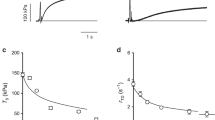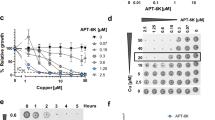Abstract
Antibiotic-induced muscle paralysis has frequently been found in both experimental animals and man with three distinct classes of antibiotic: (1) streptomycin and related aminoglycoside compounds, (2) polymyxins and (3) tetracyclines1. Recently lincomycin and its chemical congener, clindamycin, have been reported to produce muscle paralysis which has different characteristics from those seen with other classes of antibiotic2–4. Although closely related in chemical structure, lincomycin and clindamycin also seem to produce muscle paralysis by different mechanisms. Clindamycin is considered to exert a direct depressant action on muscle contractility whereas the action of lincomycin is considered to be primarily a depression of neuromuscular transmission. We report here that each of these antibiotics had a significant but different influence on endplate channel behaviour. Clindamycin increased the rate of miniature endplate current (m.e.p.c.) decay and reduced its voltage sensitivity without altering its exponential nature. Lincomycin split m.e.p.c. decay into an initial rapid phase followed by a prolonged phase.
This is a preview of subscription content, access via your institution
Access options
Subscribe to this journal
Receive 51 print issues and online access
$199.00 per year
only $3.90 per issue
Buy this article
- Purchase on Springer Link
- Instant access to full article PDF
Prices may be subject to local taxes which are calculated during checkout
Similar content being viewed by others
References
Pittinger, C. & Adamson, R. A. Rev. Pharmac. 12, 169–184 (1972).
Wright, J. M. & Collier, B. Can. J. Physiol. Pharmac. 54, 937–944 (1976).
Singh, Y. N. et al. Anesthesiology 48, 418–424 (1978).
Becker, L. D. & Miller, R. D. Anesthesiology 45, 84–87 (1976).
Ridge, R. M. A. P. J. Physiol., Lond. 217, 393–418 (1971).
Dionne, V. E. & Parsons, R. L. Nature 274, 902–904 (1978).
Anderson, C. R. & Stevens, C. F. J. Physiol., Lond. 235, 655–691 (1973).
Gage, P. W. & McBurney, R. N. J. Physiol., Lond. 244, 385–408 (1975).
Wright, R. SIAM. J. num. Analysis (in the press).
Beam, K. G. J. Physiol., Lond. 258, 279–300 (1976).
Beam, K. G. J. Physiol., Lond. 258, 301–322 (1976).
Ruff, R. L. Biophys. J. 16, 433–439 (1976).
Adler, M. & Albuquerque, E. X. J. Pharmac. exp. Ther. 196, 360–372 (1976).
Feltz, A., Large, W. A. & Trautmann, A. J. Physiol., Lond. 269, 109–130 (1977).
Adler, M., Albuquerque, E. X. & Lebeda, F. J. Molec. Pharmac. 14, 514–529 (1978).
Author information
Authors and Affiliations
Rights and permissions
About this article
Cite this article
Fiekers, J., Marshall, I. & Parsons, R. Clindamycin and lincomycin alter miniature endplate current decay. Nature 281, 680–682 (1979). https://doi.org/10.1038/281680a0
Received:
Accepted:
Issue Date:
DOI: https://doi.org/10.1038/281680a0
Comments
By submitting a comment you agree to abide by our Terms and Community Guidelines. If you find something abusive or that does not comply with our terms or guidelines please flag it as inappropriate.



